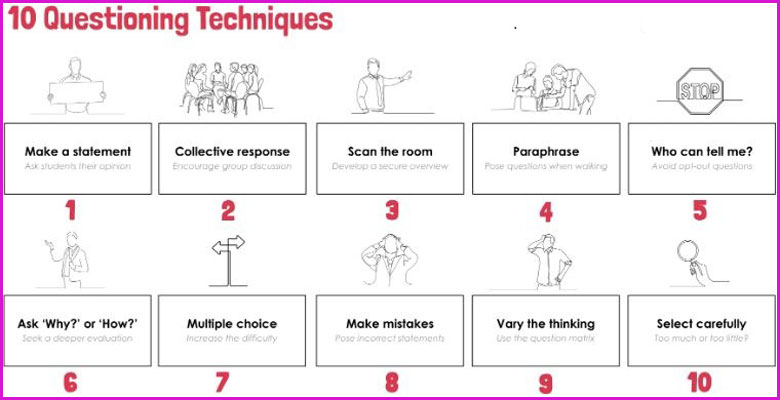What techniques do you use when questioning students? Some students can be very hesitant to answer questions and may need encouragement to speak up. How do you address this with your students? Questioning Techniques for Teachers that you’ll get here with the top 10 effective techniques.
Effective questioning techniques for teachers involve asking open-ended questions that encourage critical thinking a dynamic learning environment where students actively engage and explore concepts. These questions should be thought-provoking, relevant, and designed to stimulate discussion and deeper understanding.
Sometimes it is helpful for teachers to break down large concepts into smaller, more manageable pieces so the students to understand them better.
Top 10 Questioning Techniques for Teachers
A mix of classroom experience, thousands of hours of tutoring, professional learning, and professional reading have led to the following strategies. Therefore, to increase student involvement and comprehension, here are seven outstanding questioning methods teachers may utilize in the classroom.
Open-ended questions
An open-ended question does not provide a specific answer. They typically elicit responses by asking students to give their thoughts or ideas on the matter at hand.
Open-ends can also be used in conjunction with closed questions, which ask for specific information.
Closed questions
A closed question provides a specific answer and encourages students to share their thoughts or ideas on the topic at hand. Closed questions can also be used in conjunction with open-ended questions, which allow for more flexibility in student responses.
Use a wide variety of questions
When approaching a goal, it’s best to start a discussion by asking divergent questions and moving to convergent questions. Questions that need a broad range of intellectual (higher and lower order) thinking abilities should be asked.
For a suggestion of the sorts of inquiries that you may ask, use Bloom’s Taxonomy or Rhodes Typology. Because they encourage pupils to respond without carefully considering a concept, refrain from using YES or NO type questions.
Bloom’s Taxonomy
This is a widely used framework that helps teachers craft questions that promote higher-order thinking. It consists of six levels of cognitive complexity, ranging from lower-order thinking (e.g. remembering and understanding) to higher-order thinking (e.g. analyzing, evaluating, and creating).
Socratic questioning
This is a method of questioning that encourages students to think deeply about a subject and to arrive at their conclusions through a process of questioning and discussion.
Leading questions
These are questions that are designed to guide students toward a specific conclusion or point of view.
- Divergent questions
These questions encourage students to think about a topic from multiple perspectives or to generate multiple solutions to a problem.
Convergent questions
These are questions that require students to synthesize their understanding of a topic to arrive at a single, correct answer.
Asking clarifying questions
This is a type of question that helps students to understand the concepts being discussed in more depth.
It queries participants about their understanding of specific terms or complicated ideas.

Ask deep and meaningful follow-up questions
It’s time to ask a variety of relevant follow-up queries after you’ve used the inquiry methods outlined above. For assessing how well your pupils comprehend the information you’ve presented, follow-up questioning is vital. Students’ responses to these questions are an excellent way of identifying which pupils are at an “A” or “B” level.
Importance of questioning techniques
Questioning techniques are important because they help facilitate learning and critical thinking. By asking questions, we can clarify information, probe for deeper understanding, and evaluate evidence and arguments.
Effective questioning techniques can also help create a more interactive and engaging learning environment. Additionally, questioning can be a powerful tool for problem-solving and decision-making, as it allows us to gather information and consider multiple perspectives.
Questions that require a yes or no answer
This type of question will either ask a student if they understand the information or whether they have found anything new.
Use appropriate wait time for Questioning Techniques for Teachers
Since no one knows who will be asked to respond to the issue, waiting time encourages all students to consider the response. Afterword’s, both after posing a question and when the solution is given, the instructor may considerably improve students’ analytic and problem-solving abilities.
This enables everyone to consider both the student’s question and his or her answer. Three to five seconds is most common, with higher-order questions lasting up to ten seconds.
Summarizing what you’ve learned
This is a great way to review key concepts while reinforcing the material you’ve just covered. It allows students to consolidate what they’ve learned and assess how well it matches their prior knowledge.
Providing concrete examples
Students need to see and understand examples in order from generalization (big ideas) down to specific situations or details. When discussing complex topics, use real-world scenarios as a vehicle for teaching and learning new information.
Tips for promoting reluctant students to share their thoughts on a topic
-Be patient.
-Set a positive example by being open and respectful of others’ opinions, even when they differ from your own.
-“Come out of your shell.”
Encourage students to share their thoughts by asking questions that elicit conversational responses rather than closed-ended questions. If a student hesitates or does not want to answer a question, allow them time to think about it before prompting them to comment again.
Read also: Why do we call teachers by their last name?
How Does a Teacher Help the Community?
What Is Cultural Capital and How Does It Impact On Education?
What Do Students Need To Know About Rhetoric?
People also ask
What are questioning Techniques?
Questioning techniques refer to the strategies and methods used to ask questions in a way that promotes learning, critical thinking, and engagement.
Why do certain things happen in school?
Many factors can influence what happens in school, including the goals and policies of the school district, the curriculum and instructional methods used by teachers, the characteristics and needs of the students, and the resources and support available to the school. In truth, the school culture and the Communication between parents and teachers, students, and other staff members can also play a role in shaping the school experience.
Besides, Schools are complex systems, and it is often difficult to identify a single reason why a particular thing happens in a school.
Why use questioning techniques in teaching?
To keep students’ attention and encourage their participation, questions are a method of engaging with them.
Questions may assess, reiterate, emphasize, and/or summarize what is essential. Students’ thinking is determined by questions that stimulate debate, creative and critical thought, and stimulate discussion.
How does questioning help students learn?
Questioning is an important tool for promoting student learning because it helps engage students in critical thinking, encourages them to explore new ideas and concepts, and fosters a sense of curiosity and inquiry.
When students are asked questions, they are often required to think more deeply about a subject and to provide evidence or reasoning to support their answers. This can help students to better understand and retain new information, and can also help them to develop important skills such as problem-solving, analysis, and communication. You’ll get here the Communication between teachers and students with details.
What are some examples of questions that can be used in the classroom?
Some examples of questions that can be used in the classroom include:
-What is the main point you are trying to make?
-Why did you choose this particular example to illustrate your point?
-How could this situation be improved?
When and how do you use questioning to probe a student’s understanding?
Teachers can use questioning to probe a student’s understanding at any point during a lesson, depending on their instructional goals and the needs of their students.
It is often helpful for teachers to ask questions throughout a lesson, rather than waiting until the end. This can help to identify any misunderstandings or areas of confusion in real-time and allow teachers to provide timely support and clarification.
What are some tips for asking questions that prevent confusion or frustration among students?
Here are some tips for asking questions that can help to prevent confusion or frustration among students:
- Make sure the question is clear and concise: Avoid using complex or confusing language and be sure to clearly articulate the focus of the question.
- Provide context for the question: Help students understand the relevance of the question by providing background information or explaining how the question relates to the lesson or subject matter.
- Encourage student participation: Encourage all students to participate in discussions by asking open-ended questions and by actively listening to and acknowledging their responses.
- Use nonverbal cues: To communicate that it is acceptable for students to take their time thinking and responding, use facial expressions, gestures, and other nonverbal signals.
- Avoid leading questions: Avoid asking questions that are designed to guide students toward a specific conclusion or point of view, as this can create confusion and frustration.
How do you handle challenging questions from students?
Each question doesn’t need to be classified at a particular level by an instructor. The taxonomy is presented as a handy instrument for informing the kinds of intellectual abilities teachers demand of pupils and for assisting in verifying congruence between the teacher’s objectives and the inquiries they pose.
Rather than ascribe a particular level to questions or behaviors, many individuals use the terms “lower-level” and “higher-level.”
Understand and apply levels of the taxonomy are where lower-level questions belong. They are best suited for:
- Reviewing students’ knowledge and comprehension
- Students’ strengths and weaknesses can be diagnosed.
- Reviewing and/or summarizing material.
How do you ensure that all students feel comfortable participating in class discussions?
It is important to create a discussion-friendly environment in which all students feel comfortable participating. Some effective techniques for doing this include:
Asking open-ended questions that encourage participation
Acknowledging and responding to student responses.
Last Word
Listening is the most effective skill a teacher can have. A good listener will take in all of what the student has to say, not just select portions that agree with their perspective. I expected that already you’ve got 10 Questioning Techniques for Teachers besides,

